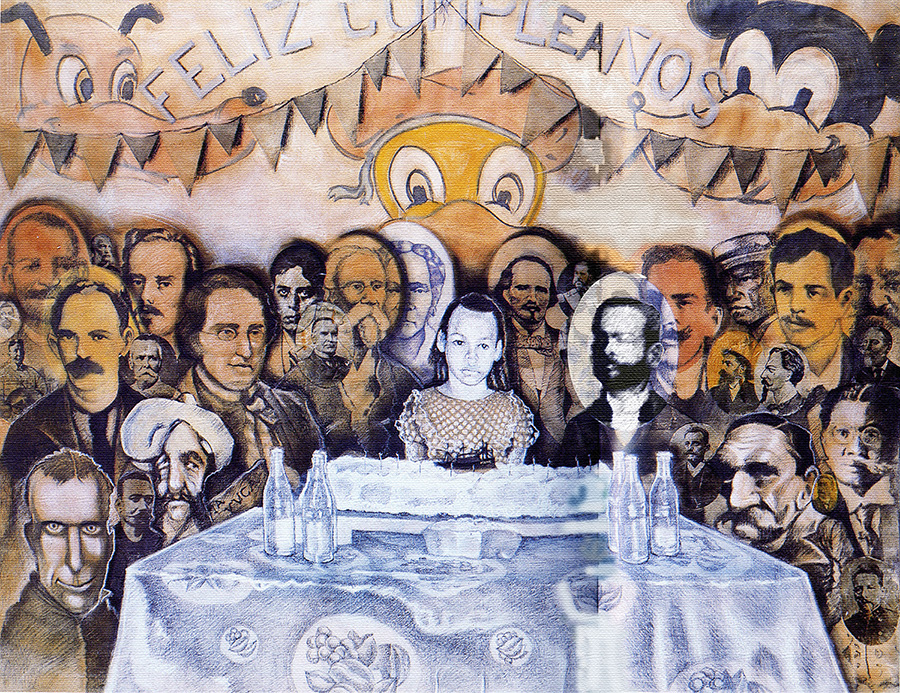Chasitie Brown
The Dormant Scar: Embodying Blackness in the Queloides Exhibition Series in Cuba, the United States, and Spain (1997–2012)
Deriving from the Greek root words chele (crab claws) and oid (like), the medical term keloid references the excessive growth of scar tissue on the epidermis. These flesh wounds typically appear due to injury or trauma, and individuals with higher levels of melanin are more susceptible to developing these scars. During the colonial period, enslaved Africans and their descendants often developed these wounds from punitive and severe lashings.
In Cuba, a group of exhibitions appeared under the title Queloides (Spanish for keloids) during the 1990s. The shows focused on questions of racial and gender identity in postrevolutionary Cuban society. Within the context of the exhibitions, the term Queloides served as a metaphor for how pathological scars appear, repeat, and persist in contemporary times—spectral reminders of the revolution’s failure to eradicate racism.

Alexis Esquivel, Pianísmo Concierto en Clave de Ifá (Grand Piano Concert in the Key of Ifá), 1997, installation, wood, glass, water, and digital print. Courtesy of the artist
My dissertation examines the three-part exhibition series Queloides (1997–2012) staged in Cuba and the United States with affiliated shows in Spain. By focusing on the exhibited painting, photography, installation, and performances that positioned the Black body as a contested site, I argue that the series articulated imaginings of Blackness centered on experiential and affective embodiments of race. That is, how Blackness feels in the body, taking the form of colonial traumas, silences, and, at times, contradictory stereotypes. Concerned with these social realities, Queloides challenged conventional readings of Blackness tied to religious Afro-Cuban folklore and patriotic allegiance to the Cuban state.
My dissertation analyzes how the Queloides series participants—artists (Alexis Esquivel, René Peña, and Gertrudis Rivalta), curators (Ariel Ribeaux), and intellectuals (Alejandro de la Fuente)—employed the exhibition format as a discursive strategy to address one of the most silenced topics in Cuba: antiblack racism. The first installment of the series, Queloides (I), was cocurated by participating artists Esquivel and Omar-Pascual Castillo in 1997. A few months later, rising art critic Ribeaux curated the intermediate exhibition, Ni músicos ni deportistas (Neither musicians nor athletes), and Queloides (II) in 1999. In 2010 Harvard professor de la Fuente and artist Elio Rodríguez curated the final installment to date.
Organized by close friends and peers, the Queloides project privileged friendship and social relations as a curatorial strategy. Through close dialogues and exchange, the project’s curators and artists thought alongside one another (at times disagreeing) on questions of race. I trace these interactions by analyzing the curators’ exhibition essays and correspondences alongside the artworks displayed in the shows.

Gertrudis Rivalta, Happy Birthday Gertrudis, 1998, mixed technique, Collection of Tom Patchett. Courtesy of the artist
My dissertation consists of four chapters that analyze each Queloides exhibition as a distinct yet interrelated unit of analysis. Chapter One contextualizes the project within the artistic landscape of Cuba in the 1980s before examining the first installment of the series, Queloides (I). Here, I examine how the exhibition sought to reveal the prevalence of racial prejudice in Cuba by providing a sociological rather than an anthropological reading of Blackness.
Chapter Two traces the contributions of curator Ribeaux, a recent art history graduate of Universidad de La Habana, who significantly refined the project’s curatorial goals while maintaining its momentum. This chapter analyzes how conceptions of Blackness evolved from general notions of antiblack racism to more detailed examples of how constructions of racial identity intersect with gender, sexuality, and historical representation. I also examine how the project expanded professionally, receiving more critical attention from Cuban art circuits and taking place in more prestigious institutions, such as the Centro de Desarrollo de las Artes Visuales in Havana.
Chapter Three examines the third installment of Queloides that traveled from Cuba to the United States. Focusing primarily on its US iteration, I read this exhibition as an archival initiative both to rewrite and preserve the legacy of the anterior shows. This updated version of Queloides placed greater attention on gender, including female artists not featured previously: María Magdalena Campos-Pons, Belkis Ayón, and Marta María Pérez Bravo. My analysis focuses on this presentation of gender, contextualizing it within feminist politics in Cuba and the United States in the 1990s and 2000s.
Lastly, Chapter Four expands upon the temporal and spatial boundaries that often frame Queloides by analyzing the project’s afterlives in Spain. I center my discussions on artists Esquivel and Rivalta, who developed a strong body of work in Spain that focused on questions of diaspora, gender, race, and memory.
The University of Texas at Austin
Twelve-Month Ittleson Fellow, 2023–2024
Chasitie Brown will return to the University of Texas at Austin in the fall of 2024, where she will complete her dissertation, funded by the University Graduate Continuing Fellowship. She is scheduled to graduate in the fall of 2025.
